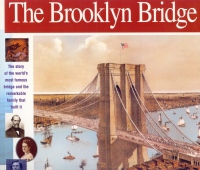| ________________
CM . . . . Volume XVIII Number 40 . . . . June 15, 2012
excerpt:
Told as a story of a family that had a vision, The Brooklyn Bridge includes many technical details which explain the steps in the process of building a suspension bridge. Back in 1852, the only way to cross the East River from New York to Brooklyn was to take a ferry. John Roebling had an idea for a bridge that would allow everyone to cross at all times of the year. While he is remembered for having designed the bridge, he was not destined to build it. His death after a boating accident passed this task to his son, Washington, who was also an engineer. Huge caissons, or supports, as never before seen in America were built first. The construction of these proved to be dangerous for the workers as illustrated in the quote above. Washington succumbed to the dreaded caisson disease and spent the rest of his time in bed, watching the construction with binoculars through his window. His wife, Emily, took up the torch, and, after gaining the respect of the other workers, she supervised the rest of the construction of the Brooklyn Bridge. Fourteen years later after many hardships and deaths, the famous Brooklyn Bridge was finished. This exceptional book is part of the “Wonders of the World Books” series by Elizabeth Mann and is of the same well-researched and quality as the rest in the series.  Written for any audience, the technical terms are explained and illustrated through diagrams and black and white photographs. Alan Witschonke’s drawings of the city and bridge in its various stages of construction entice the reader to look closely to absorb all the fine details. Many sketches are done in black ink over faded watercolors creating a back-in-time effect. Fold-out pages enable the reader to understand the length and height of the structure.
Written for any audience, the technical terms are explained and illustrated through diagrams and black and white photographs. Alan Witschonke’s drawings of the city and bridge in its various stages of construction entice the reader to look closely to absorb all the fine details. Many sketches are done in black ink over faded watercolors creating a back-in-time effect. Fold-out pages enable the reader to understand the length and height of the structure. In The Brooklyn Bridge, Elizabeth Mann has created an excellent book for all ages. Anyone who has ever wondered about how a bridge such as this one was built will enjoy the fascinating science that made it happen. Certainly, The Brooklyn Bridge is a must for any school library. Highly Recommended. Sherry Faller is a teacher-librarian in Winnipeg, MB.
To comment
on this title or this review, send mail to cm@umanitoba.ca.
Copyright © the Manitoba Library Association. Reproduction for personal
use is permitted only if this copyright notice is maintained. Any
other reproduction is prohibited without permission.
NEXT REVIEW |
TABLE OF CONTENTS FOR THIS ISSUE
- June 15, 2012.
AUTHORS |
TITLES |
MEDIA REVIEWS |
PROFILES |
BACK ISSUES |
SEARCH |
CMARCHIVE |
HOME |
||||||
